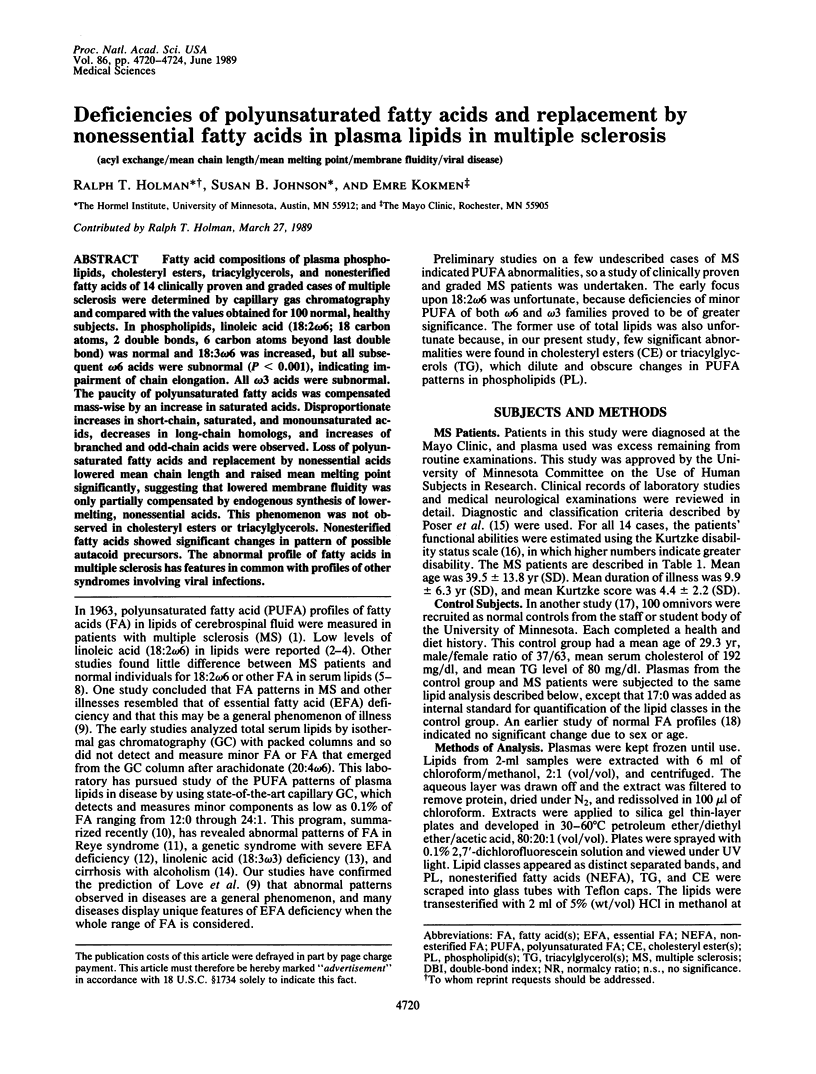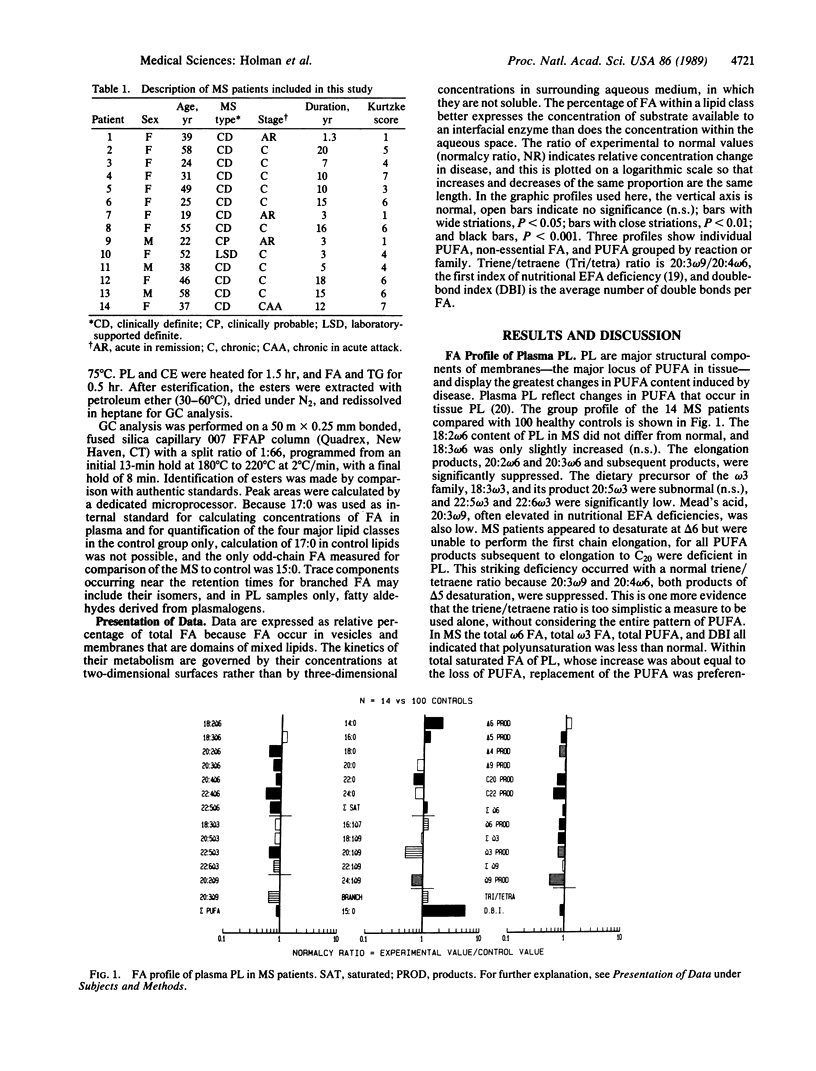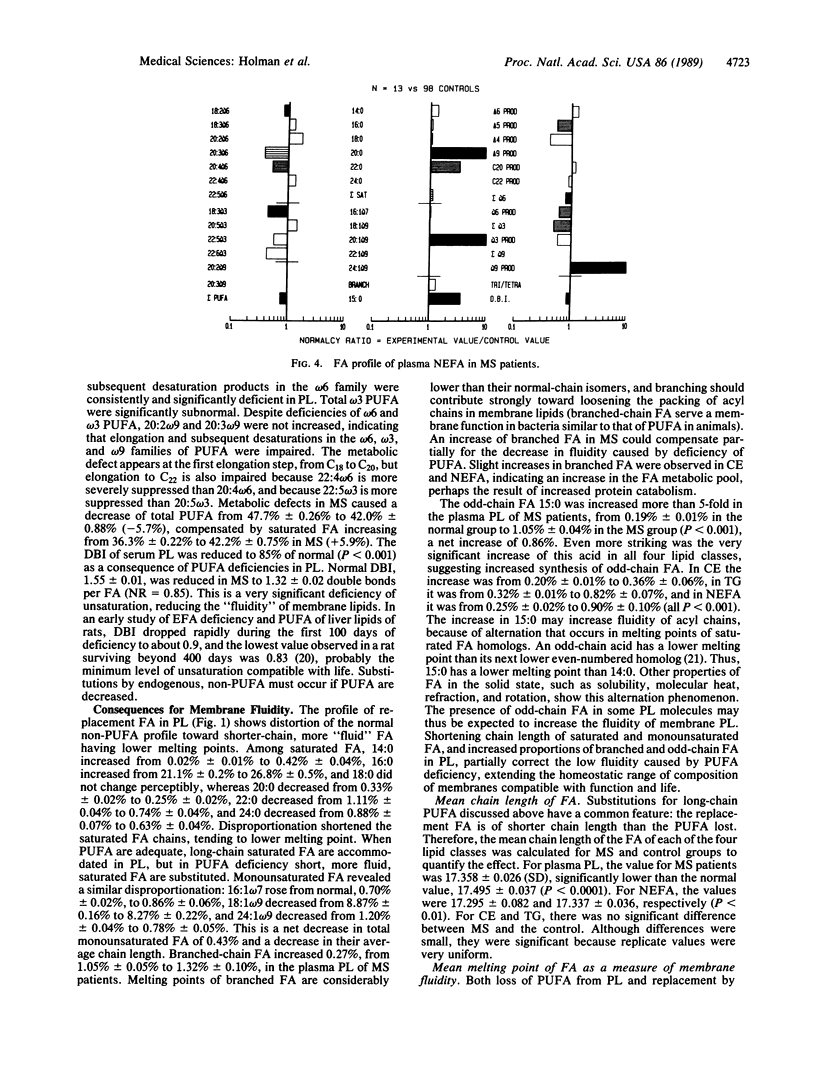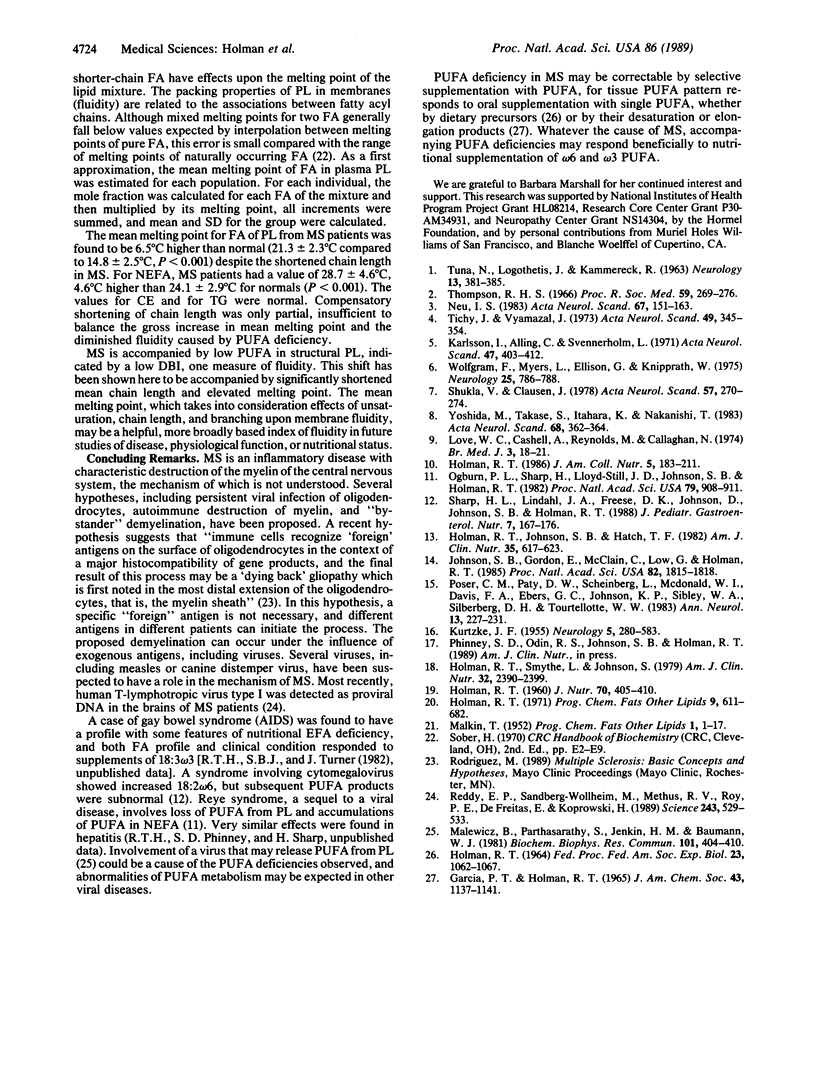Abstract
Fatty acid compositions of plasma phospholipids, cholesteryl esters, triacylglycerols, and nonesterified fatty acids of 14 clinically proven and graded cases of multiple sclerosis were determined by capillary gas chromatography and compared with the values obtained for 100 normal, healthy subjects. In phospholipids, linoleic acid (18:2 omega 6; 18 carbon atoms, 2 double bonds, 6 carbon atoms beyond last double bond) was normal and 18:3 omega 6 was increased, but all subsequent omega 6 acids were subnormal (P less than 0.001), indicating impairment of chain elongation. All omega 3 acids were subnormal. The paucity of polyunsaturated fatty acids was compensated mass-wise by an increase in saturated acids. Disproportionate increases in short-chain, saturated, and monounsaturated acids, decreases in long-chain homologs, and increases of branched and odd-chain acids were observed. Loss of polyunsaturated fatty acids and replacement by nonessential acids lowered mean chain length and raised mean melting point significantly, suggesting that lowered membrane fluidity was only partially compensated by endogenous synthesis of lower-melting, nonessential acids. This phenomenon was not observed in cholesteryl esters or triacylglycerols. Nonesterified fatty acids showed significant changes in pattern of possible autacoid precursors. The abnormal profile of fatty acids in multiple sclerosis has features in common with profiles of other syndromes involving viral infections.
Full text
PDF




Selected References
These references are in PubMed. This may not be the complete list of references from this article.
- Garcia P. T., Holman R. T. Competitive inhibitions in the metabolism of polyunsaturated fatty acids studied via the composition of phospholipids, triglycerides and cholesteryl esters of rat tissues. J Am Oil Chem Soc. 1965 Dec;42(12):1137–1141. doi: 10.1007/BF02636930. [DOI] [PubMed] [Google Scholar]
- HOLMAN R. T. NUTRITIONAL AND METABOLIC INTERRELATIONSHIPS BETWEEN FATTY ACIDS. Fed Proc. 1964 Sep-Oct;23:1062–1067. [PubMed] [Google Scholar]
- HOLMAN R. T. The ratio of trienoic: tetraenoic acids in tissue lipids as a measure of essential fatty acid requirement. J Nutr. 1960 Mar;70:405–410. doi: 10.1093/jn/70.3.405. [DOI] [PubMed] [Google Scholar]
- Holman R. T. Control of polyunsaturated acids in tissue lipids. J Am Coll Nutr. 1986;5(2):183–211. doi: 10.1080/07315724.1986.10720125. [DOI] [PubMed] [Google Scholar]
- Holman R. T., Johnson S. B., Hatch T. F. A case of human linolenic acid deficiency involving neurological abnormalities. Am J Clin Nutr. 1982 Mar;35(3):617–623. doi: 10.1093/ajcn/35.3.617. [DOI] [PubMed] [Google Scholar]
- Holman R. T., Smythe L., Johnson S. Effect of sex and age on fatty acid composition of human serum lipids. Am J Clin Nutr. 1979 Dec;32(12):2390–2399. doi: 10.1093/ajcn/32.12.2390. [DOI] [PubMed] [Google Scholar]
- Johnson S. B., Gordon E., McClain C., Low G., Holman R. T. Abnormal polyunsaturated fatty acid patterns of serum lipids in alcoholism and cirrhosis: arachidonic acid deficiency in cirrhosis. Proc Natl Acad Sci U S A. 1985 Mar;82(6):1815–1818. doi: 10.1073/pnas.82.6.1815. [DOI] [PMC free article] [PubMed] [Google Scholar]
- Karlsson I., Alling C., Svennerholm L. Major plasma lipids and their fatty acid composition in multiple sclerosis and other neurological diseases. Acta Neurol Scand. 1971;47(4):403–412. doi: 10.1111/j.1600-0404.1971.tb07495.x. [DOI] [PubMed] [Google Scholar]
- Love W. C., Cashell A., Reynolds M., Callaghan N. Linoleate and fatty-acid patterns of serum lipids in multiple sclerosis and other diseases. Br Med J. 1974 Jul 6;3(5922):18–21. doi: 10.1136/bmj.3.5922.18. [DOI] [PMC free article] [PubMed] [Google Scholar]
- Malewicz B., Parthasarathy S., Jenkin H. M., Baumann W. J. Rapid phospholipase A2 stimulation and diacylglycerol cholinephosphotransferase inhibition in baby hamster kidney cells during initiation of dengue virus infection. Biochem Biophys Res Commun. 1981 Jul 30;101(2):404–410. doi: 10.1016/0006-291x(81)91274-2. [DOI] [PubMed] [Google Scholar]
- Neu I. S. Essential fatty acids in the serum and cerebrospinal fluid of multiple sclerosis patients. Acta Neurol Scand. 1983 Mar;67(3):151–163. doi: 10.1111/j.1600-0404.1983.tb04558.x. [DOI] [PubMed] [Google Scholar]
- Ogburn P. L., Jr, Sharp H., Lloyd-Still J. D., Johnson S. B., Holman R. T. Abnormal polyunsaturated fatty acid patterns of serum lipids in Reye's syndrome. Proc Natl Acad Sci U S A. 1982 Feb;79(3):908–911. doi: 10.1073/pnas.79.3.908. [DOI] [PMC free article] [PubMed] [Google Scholar]
- Poser C. M., Paty D. W., Scheinberg L., McDonald W. I., Davis F. A., Ebers G. C., Johnson K. P., Sibley W. A., Silberberg D. H., Tourtellotte W. W. New diagnostic criteria for multiple sclerosis: guidelines for research protocols. Ann Neurol. 1983 Mar;13(3):227–231. doi: 10.1002/ana.410130302. [DOI] [PubMed] [Google Scholar]
- Reddy E. P., Sandberg-Wollheim M., Mettus R. V., Ray P. E., DeFreitas E., Koprowski H. Amplification and molecular cloning of HTLV-I sequences from DNA of multiple sclerosis patients. Science. 1989 Jan 27;243(4890):529–533. doi: 10.1126/science.2536193. [DOI] [PubMed] [Google Scholar]
- Sharp H. L., Lindahl J. A., Freese D. K., Burke B., Englund J., Johnson D., Johnson S. B., Holman R. T. A new hepato-pancreato-renal disorder resembling tyrosinemia involving neuropathy and abnormal metabolism of polyunsaturated acids. J Pediatr Gastroenterol Nutr. 1988 Mar-Apr;7(2):167–176. doi: 10.1097/00005176-198803000-00002. [DOI] [PubMed] [Google Scholar]
- Shukla V. K., Clausen J. Linoleate and fatty acid patterns of serum lipids in multiple sclerosis. Acta Neurol Scand. 1978 Mar;57(3):270–274. doi: 10.1111/j.1600-0404.1978.tb05875.x. [DOI] [PubMed] [Google Scholar]
- TUNA N., LOGOTHETIS J., KAMMERECK R. Fatty acids in spinal fluid and serum of patients with demyelinating disorders. Neurology. 1963 May;13:381–385. doi: 10.1212/wnl.13.5.381. [DOI] [PubMed] [Google Scholar]
- Thompson R. H. A biochemical approach to the problem of multiple sclerosis. Proc R Soc Med. 1966 Mar;59(3):269–276. doi: 10.1177/003591576605900332. [DOI] [PMC free article] [PubMed] [Google Scholar]
- Tichý J., Vymazal J. Changes of some serum fatty acids and lipids in relation to the clinical course of multiple sclerosis. Acta Neurol Scand. 1973;49(3):345–354. doi: 10.1111/j.1600-0404.1973.tb01308.x. [DOI] [PubMed] [Google Scholar]
- Wolfgram F., Myers L., Ellison G., Knipprath W. Serum linoleic acid in multiple sclerosis. Neurology. 1975 Aug;25(8):786–788. doi: 10.1212/wnl.25.8.786. [DOI] [PubMed] [Google Scholar]
- Yoshida M., Takase S., Itahara K., Nakanishi T. Linoleate and fatty acid compositions in the serum lipids of Japanese patients with multiple sclerosis. Acta Neurol Scand. 1983 Nov;68(5):362–364. doi: 10.1111/j.1600-0404.1983.tb04844.x. [DOI] [PubMed] [Google Scholar]


